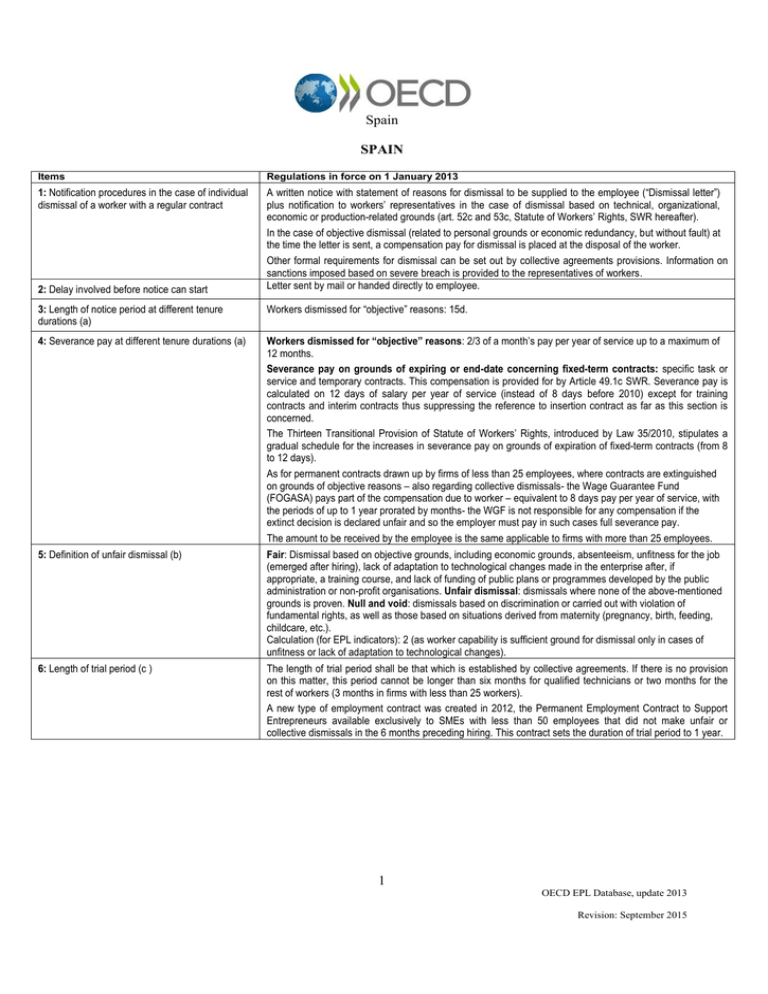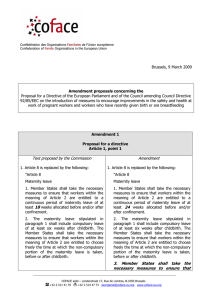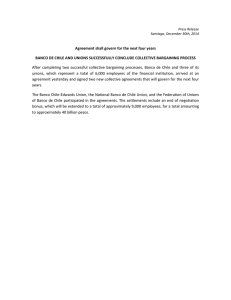Spain - OECD
Anuncio

Spain SPAIN Items Regulations in force on 1 January 2013 1: Notification procedures in the case of individual dismissal of a worker with a regular contract A written notice with statement of reasons for dismissal to be supplied to the employee (“Dismissal letter”) plus notification to workers’ representatives in the case of dismissal based on technical, organizational, economic or production-related grounds (art. 52c and 53c, Statute of Workers’ Rights, SWR hereafter). In the case of objective dismissal (related to personal grounds or economic redundancy, but without fault) at the time the letter is sent, a compensation pay for dismissal is placed at the disposal of the worker. Other formal requirements for dismissal can be set out by collective agreements provisions. Information on sanctions imposed based on severe breach is provided to the representatives of workers. Letter sent by mail or handed directly to employee. 2: Delay involved before notice can start 3: Length of notice period at different tenure durations (a) Workers dismissed for “objective” reasons: 15d. 4: Severance pay at different tenure durations (a) Workers dismissed for “objective” reasons: 2/3 of a month’s pay per year of service up to a maximum of 12 months. Severance pay on grounds of expiring or end-date concerning fixed-term contracts: specific task or service and temporary contracts. This compensation is provided for by Article 49.1c SWR. Severance pay is calculated on 12 days of salary per year of service (instead of 8 days before 2010) except for training contracts and interim contracts thus suppressing the reference to insertion contract as far as this section is concerned. The Thirteen Transitional Provision of Statute of Workers’ Rights, introduced by Law 35/2010, stipulates a gradual schedule for the increases in severance pay on grounds of expiration of fixed-term contracts (from 8 to 12 days). As for permanent contracts drawn up by firms of less than 25 employees, where contracts are extinguished on grounds of objective reasons – also regarding collective dismissals- the Wage Guarantee Fund (FOGASA) pays part of the compensation due to worker – equivalent to 8 days pay per year of service, with the periods of up to 1 year prorated by months- the WGF is not responsible for any compensation if the extinct decision is declared unfair and so the employer must pay in such cases full severance pay. The amount to be received by the employee is the same applicable to firms with more than 25 employees. 5: Definition of unfair dismissal (b) Fair: Dismissal based on objective grounds, including economic grounds, absenteeism, unfitness for the job (emerged after hiring), lack of adaptation to technological changes made in the enterprise after, if appropriate, a training course, and lack of funding of public plans or programmes developed by the public administration or non-profit organisations. Unfair dismissal: dismissals where none of the above-mentioned grounds is proven. Null and void: dismissals based on discrimination or carried out with violation of fundamental rights, as well as those based on situations derived from maternity (pregnancy, birth, feeding, childcare, etc.). Calculation (for EPL indicators): 2 (as worker capability is sufficient ground for dismissal only in cases of unfitness or lack of adaptation to technological changes). 6: Length of trial period (c ) The length of trial period shall be that which is established by collective agreements. If there is no provision on this matter, this period cannot be longer than six months for qualified technicians or two months for the rest of workers (3 months in firms with less than 25 workers). A new type of employment contract was created in 2012, the Permanent Employment Contract to Support Entrepreneurs available exclusively to SMEs with less than 50 employees that did not make unfair or collective dismissals in the 6 months preceding hiring. This contract sets the duration of trial period to 1 year. 1 OECD EPL Database, update 2013 Revision: September 2015 Spain 7: Compensation following unfair dismissal (d) The level for severance pay concerning unfair dismissal is calculated as 33 days pay per year of service with an upper limit of 24 months pay. This is fully applicable to contracts signed as from the entry into force of the Royal Decree Law 3/2012, that is 12 February 2012. As for contracts started before this date and being extinguished after it, severance pay for unfair dismissal is calculated as 45 of salary per year of service prior to 12 February 2012 33 days of salary per year of service after that date. Nevertheless, the total amount cannot be higher than 720 days of salary unless the calculation of the compensation for the previous period prior to the entry into force of the RDL 3/2012 (12nd February 2012) resulted in a higher number of days, in which case it will be applied the latter as a maximum severance pay without this amount being higher than 42 months pay, in any case. No interim wages for the duration of the judicial procedure when the employer opts for the severance pay. These interim wages remain only if the employer accepts reinstatement as an option after a dismissal is declared unfair or as a consequence of the dismissal being declared null, except for legal representatives of workers and union delegates who can choose between reinstatement and severance pay and in both cases are entitled to receive interim wages. Calculation (for EPL indicators): 22-month compensation minus severance pay as reported in item 4 (12 months). 8: Reinstatement option for the employee following unfair dismissal (b) In the case where the dismissal has been declared unfair, the employer has a choice between reinstatement and compensation, except where the dismissed employee is a legal representative of the workers or a union delegate, in which case the employee can choose between reinstatement and compensation. As regards null dismissal, reinstatement is immediate, according to Law. In addition, it implies paying the employee for the remainder of non-paid wages. 9: Maximum time period after dismissal up to which an unfair dismissal claim can be made (e) The worker can file a claim against dismissal within 20 working days following the day at which the dismissal took effect. Calculation (for EPL indicators): 20 working days = approx. one calendar month 10: Valid cases for use of standard fixed term contracts In addition to objective or “causal” reasons (for specific work, due to accumulation of tasks, replacement, temporary change in market conditions, etc.), FTCs may be stipulated for the following purposes: training contracts (professionalising contracts and contracts for training purposes); to hire workers with disabilities; and to cover the part of the working day left uncovered by an employee close to retirement with another worker who has concluded a temporary contract with the firm, or with an unemployed worker. 11: Maximum number of successive standard FTCs (initial contract plus renewals and/or prolongations) Temporary increase in workload: the contract can be extended or renewed only once, within the maximum duration. Specific task or service contracts: no limit specified, within the maximum duration. Training contracts: may be extended for six months up to two years, or three years by collective agreement, and up to four years for workers with disabilities. Professionalising contract (contrato de trabajo en prácticas): no limit specified within maximum duration. 12: Maximum cumulated duration of successive standard FTCs Specific task or service contract: 3 years allowing for a 12 months possible extension. Temporary increase in workload: 6 months within a period of 12 months or, as a maximum, 12 months within a period of 18 months. Training and apprenticeship contract: Since 12nd February 2012, 1 year minimum duration and 3 years maximum duration. No restriction on duration for a worker with disability. Professionalising contract (contrato de trabajo en prácticas): 6 months minimum duration and 2 years maximum duration. Replacement contract for workers near retirement: time left until the replaced worker reaches the age of 65, i.e. up to a maximum of 48 or 52 months, according to the age of the worker who retires. Calculation: average of increase in workload (12), specific task or service (48), training (36) and professionalising (24) contracts. 13: Types of work for which temporary work agency (TWA) employment is legal Same conditions of use as for fixed-term contracts. Additional restrictions imposed by collective agreements exist in the construction and steel industries. Since April 1, 2011 new restrictions cannot be set by collective agreements unless there are justified reasons based on general interest regarding the safety of TWA workers, on guaranteeing labour market functioning as well as to avoid possible abuse. 14: Are there restrictions on the number of renewals and/or prolongations of TWA assignments? (f) General rules applicable to temporary contracts and fixed-term employment contracts. No limitation for renewals of contracts between the agency and the worker. 2 OECD EPL Database, update 2013 Revision: September 2015 Spain 15: Maximum cumulated duration of TWA assignments (f) Limits are the same as for fixed-term contracts (Article 15 SWR) However, it should be taken into account the prohibition rule on serial contracts (article 15.5 SWR): “without prejudice to what is provided for by section 1.a), 2 and 3 of this Article workers who –within a period of 30 months- had been hired during a period longer than 24 months, with or without continuity, for the same or different occupation within the same firm or group of companies and have been hired directly either on two or more fixed-term contracts or being placed at disposal by temporary work agencies with the same or different type of fixed-term contract will acquire the condition of permanent workers” Contracts between the agency and the worker can be open-ended. Calculation (for EPL indicators): average of specific task or service (48 months) and other reasons (24 months) 16: Does the set-up of a TWA require authorisation or reporting obligations? TWAs need administrative authorisation to carry out their activities. The authorisation is valid for one year and will be extended for two successive years provided the TWA applies for the extension three months in advance of the expiry date and fulfils its legal obligations. The authorisation will be granted with no time limit when the TWA has been carrying out authorised activity for three years and expires when the TWA gives up its activity for one uninterrupted year. TWAs have monthly reporting requirements and are required to provide user firms and employee representatives with information when there is a new contract or transfer of contract. 17: Do regulations ensure equal treatment of regular workers and agency workers at the user firm? Workers hired so as to be placed at disposal of user-firms will be entitled to the essential working/employment conditions applicable had they been hired directly by the user-firm for the same job and during the time of provision of service. Essential working/employment conditions include the following (as regards remuneration): all fixed and variable components on the wage linked to the job to be performed as set out by the collective agreement applied to the user-firm. In any case it should include the proportional part corresponding to weekly days off, extra payments, public holidays and annual leave. 18: Definition of collective dismissal (b) Within 90 days, 10+ workers in firms <100 employees; 10%+ in firms 100-299 employees; 30+ workers in firms 300+ employees. 19: Additional notification requirements in cases of collective dismissal (g) Notification of employee representatives: Duty to inform and consult with Works Council or trade union delegation. Notification of public authorities: Notification of labour authority. The consultation should deal with, at least, the possibilities of avoiding or reducing collective dismissal while mitigating its effects by means of other accompanying social measures such as replacement measures or training and re-training actions for improving employability. The notification on the opening of a consultation period will be made by a written statement to representatives of workers whose content should include: -specification of causes -number and job classification of workers affected -number and job classification of workers employed during the last year. -time period to proceed with dismissals. -selection criteria regarding the workers affected by the measure. In addition, an explanatory report concerning the reasons for collective dismissal and issues related to them. In general terms, the written notification will be accompanied by all needed information so as to justify the reasons for collective dismissal. 20: Additional delays involved in cases of collective dismissal (h) Period of required consultation with the representatives of workers of 30 days (15 days in enterprises of less than 50 workers). There is also the possibility that the labour authority contest the arrangements achieved during the consultation period if considered to be concluded unlawfully, deceit, by coercion or abuse or where the benefit management institution reports irregularities. And the Labour and Social Security Inspectorate can intervene in the proceeding issuing a report on the issues raised in the employer’s notification initiating the procedure, as well as concerning the unemployment benefits management institution. Once the period of consultation has ended, the employer must notify, on individual basis, the decision of dismissal to workers concerned. Calculation (for EPL indicators): 30 days for consultation. 3 OECD EPL Database, update 2013 Revision: September 2015 Spain 21: Other special costs to employers in case of collective dismissals (i) The consultation with representatives must be aimed at, at least, avoiding or reducing collective dismissal while mitigating its effects by means of accompanying social measures such as replacement measures, or training and occupational retraining for improving employability. Design for accompanying social measures: Firms carrying out a collective dismissal affecting more than 50 workers should offer to these employees concerned an external replacement plan through the authorized employment agencies. This plan, designed for a minimum period of 6 months should include training actions and professional counselling measures, personalized assistance to the employee concerned as well as an active job-seeking support. In any case, the abovementioned is not applicable to those firms that are subject to a bankruptcy procedure. The cost of carrying out this plan will not fall on workers, in any case. The non-compliance with this obligation as regards accompanying social measures taken on by the employer could result in a legal claim for its compliance by the workers. Calculation (for EPL indicators): average of large and small size of dismissal (1+0)/2=0.5 Legend: d: days; w: weeks; m: months; y: years. For example “1m < 3y” means “1 month of notice (or severance) pay is required when length of service is below 3 years”. Notes: a) Three tenure durations (9 months, 4 years, 20 years). Case of a regular employee with tenure beyond any trial period, dismissed on personal grounds or economic redundancy, but without fault (where relevant, calculations of scores to compute OECD EPL indicators assume that the worker was 35 years old at the start of employment). Averages are taken where different situations apply – e.g. blue collar and white collar; dismissals for personal reasons and for redundancy. b) Based also on case law, if court practice tends to be more (or less) restrictive than what specified in legislation. c) Initial period within which regular contracts are not fully covered by employment protection provisions and unfair dismissal claims cannot usually be made. d) Typical compensation at 20 years of tenure, including back pay and other compensation (e.g. for future lost earnings in lieu of reinstatement or psychological injury), but excluding ordinary severance pay and pay in lieu of notice. Where relevant, calculations of scores to compute OECD EPL indicators assume that the worker was 35 years old at the start of employment and that a court case takes 6 months on average. Description based also on case law. e) Maximum time period after dismissal up to which an unfair dismissal claim can be made. f) Description based on both regulations on number and duration of the contract(s) between the temporary work agency and the employee and regulations on the number and duration of the assignment(s) with the same user firm. g) Notification requirements to works councils (or employee representatives), and to government authorities such as public employment offices. Only requirements on top of those requirements applying to individual redundancy dismissal count for the OECD EPL indicators (cf. Item 1). h) Additional delays and notice periods in the case of collective dismissal (only delays on top of those required for individual dismissals – as reported in Items 2 and 3 – count for the OECD EPL indicators). i) This refers to whether there are additional severance pay requirements and whether social compensation plans (detailing measures of reemployment, retraining, outplacement, etc.) are obligatory or common practice. 4 OECD EPL Database, update 2013 Revision: September 2015






